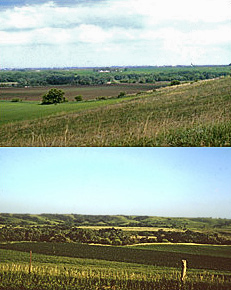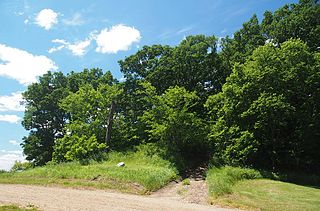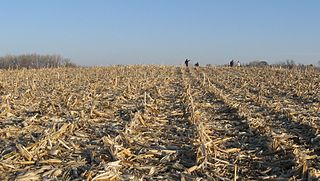
Oneota is a designation archaeologists use to refer to a cultural complex that existed in the eastern plains and Great Lakes area of what is now occupied by the United States from around AD 900 to around 1650 or 1700. Based on classification defined in Gordon Willey and Philip Phillips' 1958 book Method and Theory in American Archaeology, the Oneota culture belongs to formative stage. The culture is believed to have transitioned into various Siouan cultures of the protohistoric and historic times, such as the Ioway. A long-accepted ancestry to the Ho-chunk has yet to be conclusively demonstrated.

The Toolesboro Mound Group, a National Historic Landmark, is a group of Havana Hopewell culture earthworks on the north bank of the Iowa River near its discharge into the Mississippi. The mounds are owned and displayed to the public by the State Historical Society of Iowa. The mound group is located east of Wapello, Iowa, near the unincorporated community of Toolesboro.

The Blood Run Site is an archaeological site on the border of the US states of Iowa and South Dakota. The site was essentially populated for 8,500 years, within which earthworks structures were built by the Oneota Culture and occupied descendant tribes such as the Ioway, Otoe, Missouri, and shared with Quapaw and later Kansa, Osage, and Omaha people. The site was so named on account of the iron-stained soil.

Leary Site, also known as 25-RH-1 or Leary-Kelly Site is an archaeological site near Rulo, Nebraska and the Big Nemaha River. The site now lies entirely on the reservation of the Iowa Tribe of Kansas and Nebraska. The area was once a village and burial site.

The archaeology of Iowa is the study of the buried remains of human culture within the U.S. state of Iowa from the earliest prehistoric through the late historic periods. When the American Indians first arrived in what is now Iowa more than 13,000 years ago, they were hunters and gatherers living in a Pleistocene glacial landscape. By the time European explorers visited Iowa, American Indians were largely settled farmers with complex economic, social, and political systems. This transformation happened gradually. During the Archaic period American Indians adapted to local environments and ecosystems, slowly becoming more sedentary as populations increased. More than 3,000 years ago, during the Late Archaic period, American Indians in Iowa began utilizing domesticated plants. The subsequent Woodland period saw an increase on the reliance on agriculture and social complexity, with increased use of mounds, ceramics, and specialized subsistence. During the Late Prehistoric period increased use of maize and social changes led to social flourishing and nucleated settlements. The arrival of European trade goods and diseases in the Protohistoric period led to dramatic population shifts and economic and social upheaval, with the arrival of new tribes and early European explorers and traders. During the Historical period European traders and American Indians in Iowa gave way to American settlers and Iowa was transformed into an agricultural state.

The Utz Site, designated by the Smithsonian trinomial 23SA2, is a major Native American archaeological site in Saline County, Missouri, located on bluffs overlooking the Missouri River. Partially preserved in Van Meter State Park, it is the site of one of the largest early Contact Native villages in the region, which was occupied by the Missouri tribe from c. 15th to the late 18th centuries, and was probably the principal village area occupied by them at the time of their first contact with Europeans. The site was designated a National Historic Landmark in 1964.

The Mines of Spain State Recreation Area and E. B. Lyons Nature Center is a state park in Dubuque County, Iowa, United States. It is near Dubuque, the eighth-largest city in the state. The park features picnic areas, 15 miles (24 km) of walking/hiking trails, 4 miles (6.4 km) of ski trails, and the Betty Hauptli Bird and Butterfly Garden. It also includes archaeological sites of national importance as an early lead mining and smelting venture led by French explorer Julien Dubuque, as well as Dubuque's gravesite. These sites were collectively designated a National Historic Landmark District as Julien Dubuque's Mines.

The Upper Mississippian cultures were located in the Upper Mississippi basin and Great Lakes region of the American Midwest. They were in existence from approximately A.D. 1000 until the Protohistoric and early Historic periods.

American Indians of Iowa include numerous Native American tribes and prehistoric cultures that have lived in this territory for thousands of years. There has been movement both within the territory, by prehistoric cultures that descended into historic tribes, and by other historic tribes that migrated into the territory from eastern territories. In some cases they were pushed by development pressure and warfare.

The Oliver Phase is the name for a Late Woodland Native American culture that flourished from 1200 and 1450 CE along the east and west forks of the White River in central and southern Indiana. The Oliver Phase is of the Western Basin Tradition which includes the Springwells Phase, the Younge Phase, and the Riviere au Vase Phase. Oliver people were village dwelling farmers with a heavy reliance on maize, very similar to other Late Woodland peoples in the area the Oneota, Fort Ancient, and Monongahela cultures. The name was originally coined by archaeologist James B. Griffin in 1946 to describe a Late Woodland ceramic complex centered in Hamilton and Marion counties in the valley of the West Fork of the White River first extensively studied at the Bowen site.

The Glenwood Culture was a population of Indigenous peoples of North America prior to historical times. The culture is recognized as an eastern extension of the Nebraska Phase of the Woodland period, and was not a Mississippian culture.

The Summer Island Site, designated 20DE4, is an archaeological site located on the northwest side of Summer Island, in Delta County, Michigan. It is classified as a stratified, multi-component site with Middle Woodland, Upper Mississippian and Early Historic/Protohistoric occupations. It was listed on the National Register of Historic Places in 1971.

The Mountain Lake Site is an archaeological site in Mountain Lake Township, Minnesota, United States. It is a deeply stratified village site spanning the precontact era from the late Archaic to an Oneota occupation, with a particular concentration of Woodland period ceramics. The site is atop a hill that was formerly an island in a lake. The site was listed on the National Register of Historic Places in 1977 for its state significance in the theme of archaeology.

The Juntunen Site, also known as 20MK1, is a stratified Prehistoric Late Woodland fishing village located on the western tip of Bois Blanc Island. It was listed on the National Register of Historic Places in 1978.

Kimball Village is an archaeological site located in the vicinity of Westfield, Iowa, United States. It is one of six known Big Sioux phase villages from the Middle Missouri Tradition that existed between 1100-1250 C.E. The site, located on a terrace overlooking the Big Sioux River, has well-preserved features, including earth lodge and storage pits, and evidence of fortifaction. The site was listed on the National Register of Historic Places in 2010, and as a National Historic Landmark in 2016.

The Oak Forest Site (11Ck-53) is located in Oak Forest, Cook County, Illinois, near the city of Chicago. It is classified as a late Prehistoric to Protohistoric/Early Historic site with Upper Mississippian Huber affiliation.

The Carcajou Point Site is located in Jefferson County, Wisconsin, on Lake Koshkonong. It is a multi-component site with Prehistoric Upper Mississippian Oneota and Historic components.

The Upper Iowa River Oneota Site Complex is a series of 7 Iowa archaeological sites located within a few miles of each other in Allamakee County, Iowa, on or near the Upper Iowa River. They are all affiliated with the Late Prehistoric Upper Mississippian Oneota Orr Focus. In some cases there are early European trade goods present, indicating occupation continued into the Protohistoric or early Historic period.
![Midway Site (47LC19) Archaeological site in [[Wisconsin]], United States](https://upload.wikimedia.org/wikipedia/commons/thumb/2/27/USA_Wisconsin_location_map.svg/312px-USA_Wisconsin_location_map.svg.png)
The Midway Site (47LC19) is a Prehistoric Upper Mississippian Oneota site in La Crosse County, Wisconsin. It is located about 10 miles north of LaCrosse near the juncture of the Black and Mississippi Rivers.

The Guthrie Archeological Site is a Native American archaeological site in Saline County, Missouri, located near the Missouri River east of the city of Miami, Missouri. The site was listed on the National Register of Historic Places in 1970.



















